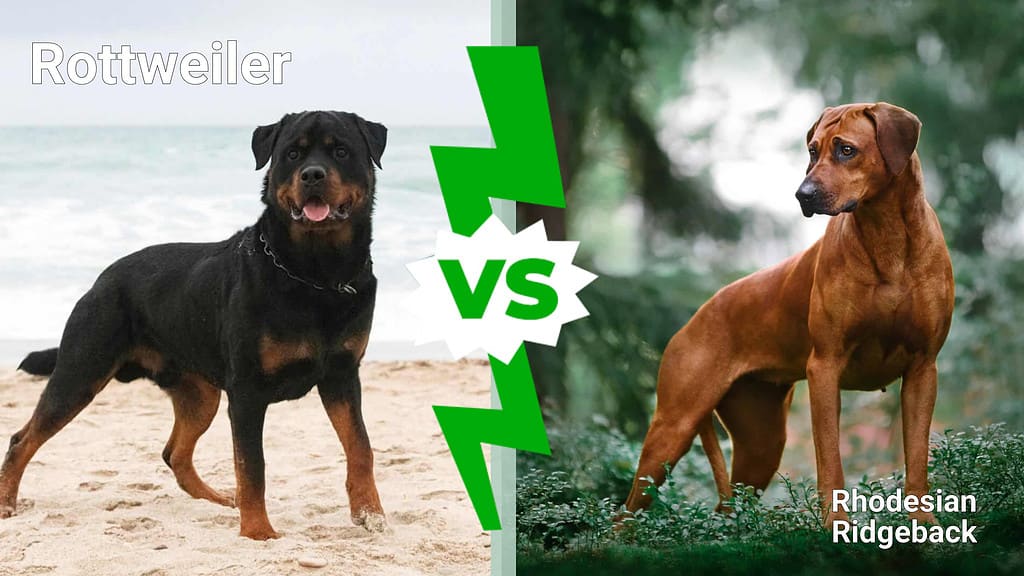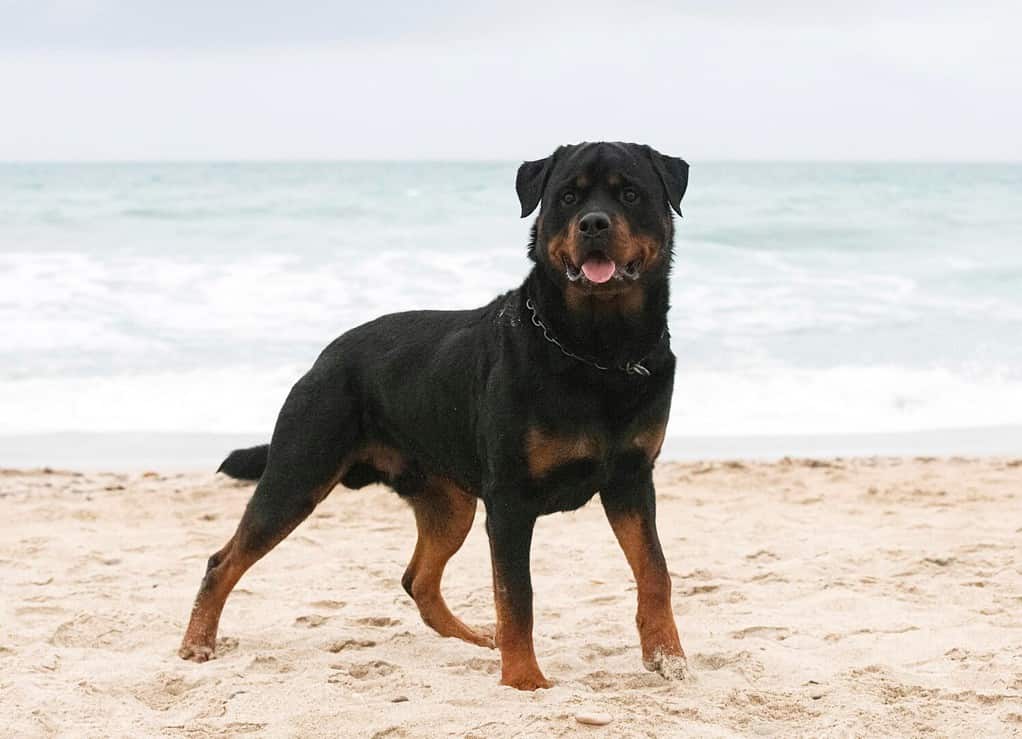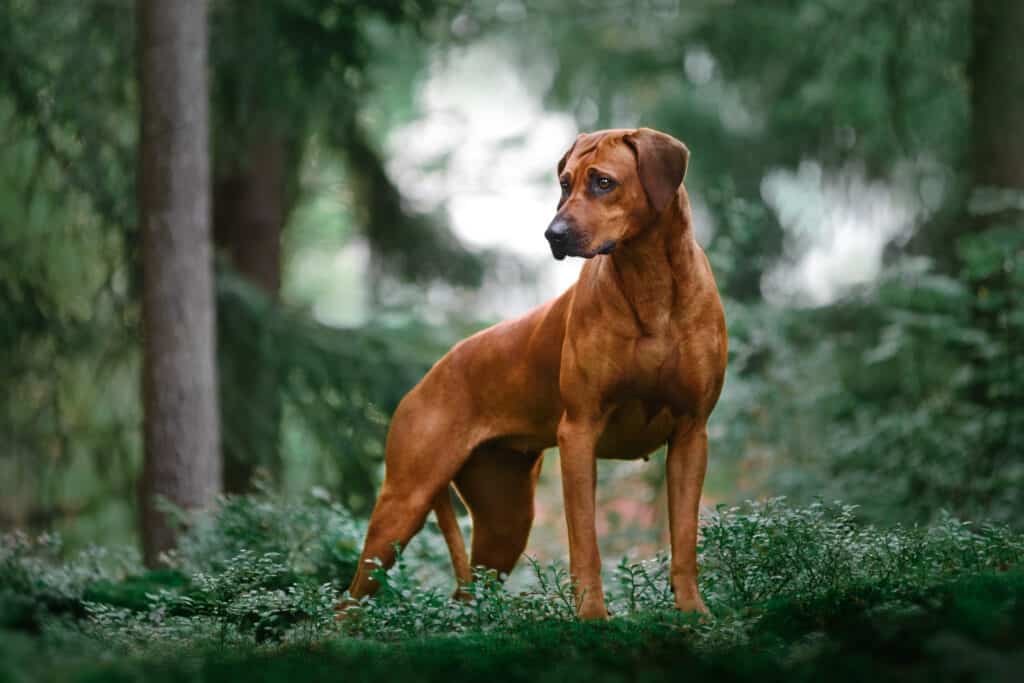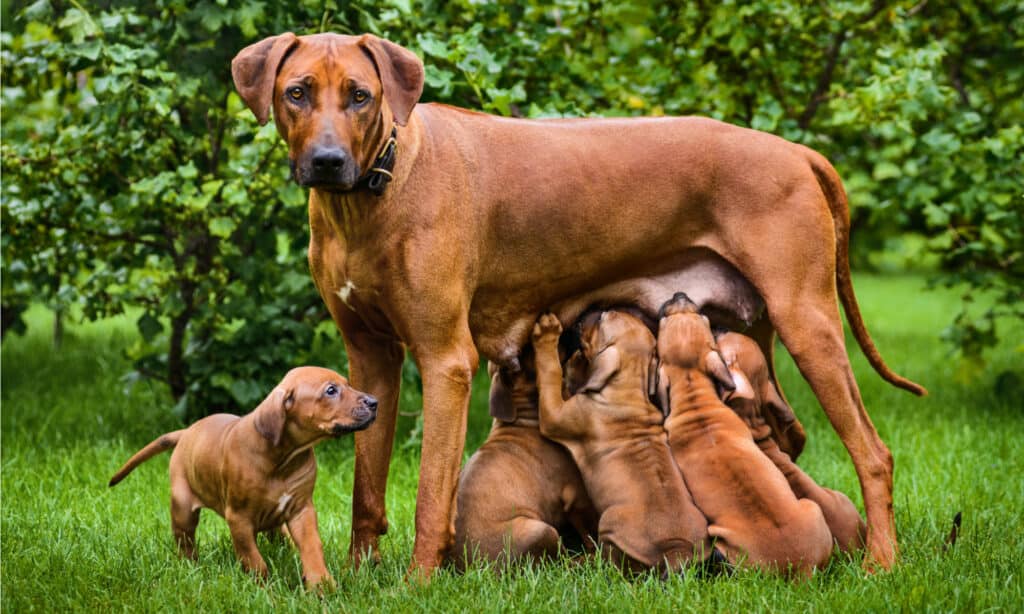Rottweilers vs Rhodesian Ridgebacks: Which breed makes the best pet for you? Let’s dive into their similarities and differences to find out!
Rottweilers are larger, sometimes nearly doubling Rhodesian Ridgebacks in size. They also have darker coats, require more daily exercise, and are a bit easier to train. Rhodesian Ridgebacks tend to be healthier and live longer lifespans.
In this article, we’ll discuss eight key differences between Rottweilers and Rhodesian Ridgebacks.
Rottweiler vs Rhodesian Ridgeback: A Comparison

| Key Differences | Rottweiler | Rhodesian Ridgeback |
|---|---|---|
| Height | 22-27 inches | 24-27 inches |
| Weight | 80-135 pounds | 70-85 pounds |
| Coat | Short black coat with rust markings | Short coat ranging in color from light wheaten to red wheaten |
| Temperament | Affectionate, playful, protective, reserved with strangers | Affectionate, protective, reserved with strangers |
| Exercise Needs | Moderate | Moderate |
| Trainability | Very easy | Easy |
| Life Expectancy | 9-10 years | 10-12 years |
| Health Problems | Prone to hip and elbow dysplasia, eye and heart conditions, and brachycephalic airway syndrome | Prone to hip and elbow dysplasia, thyroid disease, eye and heart conditions, and deafness. |
8 Key Differences Between Rottweilers and Rhodesian Ridgebacks
The key differences between Rottweilers and Rhodesian Ridgebacks include size, coat colors, temperament, exercise needs, trainability, life expectancy, and health.
Rottweilers are larger dogs with black coats, while Rhodesian Ridgeback coats can be varying shades of wheaten. Rotties are a bit easier to train and have higher energy levels but can have more health problems due to their short snouts. Rhodesian Ridgebacks have longer life expectancies.
In this article, we’ll discuss all of the differences between these breeds in-depth so that you can learn more about them, and maybe decide if one of these breeds is right for you!
Appearance

Rottweilers have black fur with rust markings, while Rhodesian Ridgebacks have wheaten-colored coats.
©cynoclub/Shutterstock.com
Height
Rottweilers and Rhodesian Ridgebacks are nearly the same heights, but Rotties on the shorter end of the spectrum will be smaller. Because female dogs of both breeds are shorter, you’ll see the largest difference between them and a much smaller difference between males.
Rottweilers stand 22-27 inches tall at the shoulder, while Rhodesian Ridgebacks are 24-27 inches tall.
Weight
While Rhodesian Ridgebacks are taller on average, they tend to weigh less. Rottweilers carry more weight with their compact bodies, while Rhodesian Ridgebacks have lithe frames.
Rotties weigh 80-135 pounds while Rhodesian Ridgebacks weigh just 70-85 pounds.
This major difference can make Rottweilers more expensive to feed, and their veterinary costs may increase as well.
It’s important to consider how much dog you can manage! The more your dog weighs, the harder it is to manage them if they pull on the leash during walks. It can also be difficult to lift a 135-pound Rottie in case of an emergency.
On the other hand, larger dogs make more intimidating guard dogs if you’re looking for a deterrent–but, both of these dogs are plenty large enough to scare off most intruders!
Coat
Rottweilers have black coats with rust, mahogany, or tan markings. These shades are quite similar, and the breed standard has very specific criteria for acceptable markings. This leaves little variation in Rottie coats.
Here are the markings a Rottweiler should have according to the American Kennel Club (AKC) breed standard:
- One over each eye
- On the cheeks
- A strip around the muzzle that doesn’t touch the bridge of the nose
- On the throat
- Triangle-shaped markings on either side of the chest
- From front wrist joints to toes with black penciling on toes
- Patches on interior rear legs extending to the exterior of the legs from the hocks downward
- Beneath the tail
Their undercoats may be gray, tan, or black, but shouldn’t show through the top coat. The AKC also specifies that markings shouldn’t cover more than 10% of a dog’s body.
Meanwhile, Rhodesian Ridgebacks can range in color from light wheaten to red wheaten. They may have black markings on the face around the muzzle and eyes, but not a full mask over the eyes. Some dogs have small white spots on their chests.
Characteristics

Both breeds are very affectionate and can be prone to separation anxiety.
©olgagorovenko/Shutterstock.com
Temperament
Both breeds tend to be confident, smart, and affectionate toward family. Many individuals are snuggle bugs or big “lap puppies.” Rottweilers tend to be more playful than Rhodesian Ridgebacks, which is one of their only differences in temperament.
Rotties are also more biddable and have a strong drive to work, while Rhodesian Ridgebacks are more laid-back.
Both breeds may be aloof or shy around strangers. It takes them time to warm up to people, which is part of the reason they make good guard dogs.
Of course, this also makes early socialization important so that your pup doesn’t become anxious or aggressive in social settings.
Social Needs
Both breeds are predisposed to dog aggression, which doesn’t necessarily mean they can’t live with other dogs. It does mean that an extra level of caution is warranted, especially during introductions. Some dogs won’t be able to interact with others, and it’s important to be able to deal with that reality should it arise.
When it comes to children, both breeds can do well if properly socialized. Never leave dogs and children together unattended.
Both breeds are also quite clingy and prone to separation anxiety. It’s important that they learn to be alone for short periods, but just as vital that they aren’t left alone for too long. They do best in families where someone is home most of the day.
Exercise Needs
Rhodesian Ridgebacks require moderate exercise and should be happy with regular walks and play. Please keep in mind that these dogs need space to run, so their ideal homes are houses with large backyards.
Once these dogs are tired, they’re usually very calm for the remainder of the day. They don’t tend to have the same endurance as Rottweilers.
Rotties are high-energy working dogs that need a large amount of daily exercise. They’re great fits for active people who like to hike, run, or go for long walks. They also like to swim and love to be given physical tasks that act as a “job” for them to do.
Mental Enrichment
Rottweilers also require more mental enrichment, but both breeds are intelligent and need their brains occupied throughout the day.
Enrichment doesn’t have to be complex. Scatter feeding your dog’s meals is an easy activity that encourages foraging, as can hiding treats around the house or using puzzle toys.
Games of fetch or flirt poles satisfy chasing and hunting instincts. And as guard dogs, just watching the world around them can be quite engaging!
Training new cues is another good way to engage your dog’s mind.
Trainability
It’s vital that these strong, independent dogs are trained properly by knowledgeable owners. Their guarding instincts and higher tendency toward dog aggression can make these breeds dangerous if kept by the wrong humans.
Luckily, both breeds are quite biddable and easy to train, so long as you keep them engaged and use the right methods.
Never try to dominate your dog or to become alpha or pack leader. Do not use aversive training methods including physical punishment, shock collars, and shouting. These training methods are outdated, harmful to all dogs, and often promote fearfulness and aggression.
Instead, use only force-free training methods (also known as relationship-based or science-based training).
Focus on socialization, but remember that this doesn’t mean interacting with many people or dogs. Socialization is a process of introducing your dog to new experiences to avoid fear and stress in their day-to-day lives.
For instance, your dog-aggressive pup doesn’t need to play with other dogs. But, they should learn to pass them on a walk without a big reaction. Socialization can also be as simple as getting your dog used to the sound of a vacuum or teaching them not to fear people wearing hats.
Health Factors

Rottweilers are more playful than Rhodesian Ridgebacks.
©Donamen/Shutterstock.com
Life Expectancy
Rottweilers live 9-10 years on average, while Rhodesian Ridgebacks live longer at 10-12 years.
This difference may come down to genetics in various ways but especially when it comes to size. Rotties are much larger than Rhodesian Ridgebacks, and larger dog breeds tend to live shorter lives.
Of course, there are no guarantees–some Rotties greatly surpass their life expectancy, and some Rhodesian Ridgebacks don’t live as long as expected.
The best way to give your dog a long, healthy life, regardless of breed, is to care for them properly. This means maintaining their weight, feeding them a balanced diet, providing daily exercise, and bringing them to the veterinarian for yearly check-ups and when sick.
Health Problems
One of the big health problems that Rottweilers face, and Rhodesian Ridgebacks don’t, is brachycephalic syndrome.
This is a set of health problems that stem from their short snouts, including difficulty breathing, exercising, and maintaining their body temperature. Unfortunately, this is a result of poor breeding.
If you’re looking to adopt a Rottweiler from a breeder, look for those who purposefully breed for longer snouts. Those who breed brachycephalic dogs are unethical.
You’ll also want to look for breeders who have OFA test results published for other common health issues, including:
- Hip and elbow dysplasia
- Eye problems
- Heart conditions
- Juvenile Laryngeal Paralysis & Polyneuropathy
Rhodesian Ridgeback breeders should complete genetic health tests for the following:
- Hip and elbow dysplasia
- Eye problems
- Heart conditions
- Autoimmune Thyroiditis
- Deafness
Wrapping Up: Rottweiler vs Rhodesian Ridgeback

Rhodesian Ridgebacks have slightly longer life expectancies, living an average of 10-12 years.
©olgagorovenko/Shutterstock.com
The main differences to consider between these breeds are size, energy levels, and health.
When considering adopting one of these dogs, think about your food budget! Rotties will need to eat more to maintain a good weight, while Rhodesian Ridgebacks will often be cheaper to feed. Larger dogs are also more difficult to manage on a leash or to lift in an emergency.
Rotties also need much more exercise, so your daily activity levels should play a role in your decision as well.
If you want to adopt a puppy from a breeder, it will be best to opt for a Rhodesian Ridgeback or a Rottweiler that was bred to have a longer snout. This way, you avoid supporting unethical breeding practices.
It’s also important to think about how much time you have to spend with your dog, and whether you can afford a pet sitter if you work full-time outside of the home and don’t have other family members to keep your dog company. These breeds don’t do well when left alone for long periods.
Can A Rhodesian Ridgeback Defeat a Lion?

Rhodesian ridgebacks were bred to hunt lions, not kill them, and their excellent hunting skills enabled them to drive lions toward the hunter.
©Eric Isselee/Shutterstock.com
Rhodesian ridgebacks are native to South Africa in the country formerly known as Rhodesia (now called Zimbabwe) where they are descended from the semi-domesticated hunting dogs of the Khoikhoi people and other dogs like the mastiff, Great Dane, Greyhound, and bloodhound, that were brought over by European settlers. Although they are known as lion-hunting dogs or the African lion dog, they don’t actually hunt lions.
These dogs were bred to hunt lions, not kill them, and their excellent hunting skills enabled them to not only track down their prey but to either keep them at bay until the hunter arrived or drive them toward the hunter. While they can be aggressive and are very muscular, if matched against a lion in a fight, they would not win.
Thank you for reading! If you have feedback on this post, please contact the AZ Animals editorial team.
The photo featured at the top of this post is ©
Ready to discover the top 10 cutest dog breeds in the entire world?
How about the fastest dogs, the largest dogs and those that are -- quite frankly -- just the kindest dogs on the planet? Each day, AZ Animals sends out lists just like this to our thousands of email subscribers. And the best part? It's FREE. Join today by entering your email below.
Thank you for reading! Have some feedback for us? Contact the AZ Animals editorial team.







